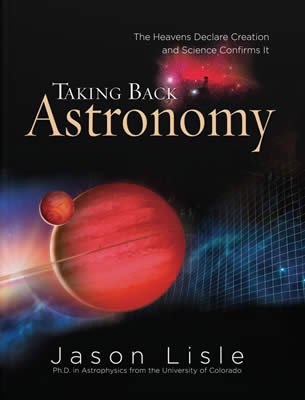
Chapter 1
The Splendor of God’s Creation
“The heavens declare the glory of God; the skies proclaim the work of his hands
” (NIV). This beautiful statement from Psalm 19:1 (NIV) indicates one of the purposes of the created universe: the universe reveals the majesty of its Creator. Of course, God’s glory can be seen in many different aspects of creation—not just the heavens. Consider the magnificent intricacy of a living cell, the complexity and the amazing diversity of life on earth, and the mathematical precision of the laws of physics and chemistry. These are all indicative of the incomprehensible creativity, intelligence, and power of the Creator.
Why then does the Bible single out the heavens as declaring His glory? Perhaps the heavens declare God’s glory in a special way or to a greater extent. It may even be that the starry universe was specially designed for the purpose of declaring God’s glory to us. We will see that the universe has incredible beauty. This alone would be sufficient reason to praise God for His creation, but not only did God make the universe beautiful, He made it unimaginably large. The range of scales in the universe is truly staggering. The universe contains objects of incredible size and mass at distances which the human mind cannot fully grasp. When we consider the power of the Lord who made all this, we cannot help but feel humbled. Truly, the God who created this universe is glorious and worthy of praise. Let us now explore the size and beauty of the universe to gain an appreciation for the majesty of the Creator.

The moon is about the same size as the United States of America.
Let’s start close to home, with a relatively small astronomical object. The moon is the nearest (natural) celestial body. It is approximately 2,100 miles (3,400 kilometers) in diameter—roughly the size of the continental United States. The moon orbits at an average distance of 240,000 miles (380,000 km) from the earth. On the one hand, this is a tremendous distance. On the other hand, it is not so far as to be totally incomprehensible; some cars have as many miles on them as this. The moon orbits the earth in a roughly circular path, taking about one month from start to finish. In fact, that is where we get the idea for a “month.” According to Scripture, one of the reasons God created the celestial bodies was to be for signs, seasons, days, and years (Genesis 1:14)—in other words, to mark the passage of time. The moon does just that. It continually orbits the earth every month with clockwork precision.
Additionally, the moon (the “lesser light” created on day 4) was designed to “rule the night,” according to Genesis 1:16. Indeed, the moon does rule the night; it outshines every other nighttime celestial object. In fact, when the moon is out, it has a tendency to “wash out” most other astronomical objects, making them more difficult to see. This effect is particularly evident when the moon is near its full phase. At that time, the moon is over 2,500 times brighter than the next brightest nighttime object (Venus).
Let us move farther out into space, and consider the “greater light” that God created on day 4—the sun. The sun (like other stars) is a glowing hot ball of hydrogen gas. It derives energy from the fusion of hydrogen to helium in the core. The sun is effectively a stable hydrogen bomb. It is an extremely efficient source of energy, placed at just the right distance to provide the right amount of light and heat for the earth.
The sun is about 400 times more distant than the moon. Remarkably, it is also 400 times larger. So it has the same angular size as the moon1—meaning it appears the same size and covers the same portion of the sky. It is interesting that God made both of the “great lights” the same angular size—and far larger (in angle) than any of the other celestial objects. There is no naturalistic reason why the sun and moon would be at just the right distances to have the same apparent size as seen from earth. As far as we know, the earth is the only planet for which this is the case.2
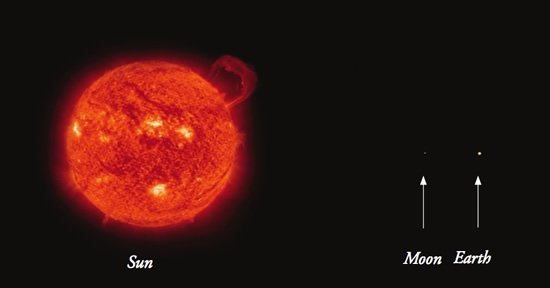
The relative size of the sun, moon, and Earth.
The sun is over 100 times the diameter of the earth. If it were hollow, it could hold over 1 million earths. At first, it seems almost “wasteful” to create such a massive globe merely to provide light for earth: until we consider that God created the sun just as easily as the rest of the universe. It wasn’t at all difficult for Him (Jeremiah 32:17) and it demonstrates His great power. At the incredible distance of 93 million miles (150 million km), we cannot fully appreciate just how far away the sun is. An analogy may be helpful. How long would it take to drive 93 million miles? If we were to drive 65 miles per hour (105 km/hr), it would take 163 years to drive this distance. We couldn’t drive this far in our lifetime.
The sun is far from the earth, and yet the earth is much closer to the sun than many of the other planets. Consider Pluto, a tiny frozen world at the outer edge of the planets of the solar system. Pluto (on average) is about 40 times farther away from the sun than the earth is. Traveling at 65 miles per hour, it would take about 6,500 years to reach Pluto. This is comparable to the age of the universe. The solar system is truly vast; if it had been the only thing God had made, we should certainly be impressed. Yet, God has created on even larger scales. Consider the distances between the stars.
Let’s start with the nearest star system to the earth (besides the sun), the Alpha Centauri system. Unlike the solar system, Alpha Centauri contains more than one star. Two bright stars (comparable to the sun in size and color) revolve around each other every 80 years. A third faint red dwarf star called “Proxima” lies farther away. The distance to this system is about 25 trillion miles. Such a number has little meaning to most of us; who can comprehend 25 trillion miles? This is about 6,800 times farther away from the earth than Pluto is.
To help grasp this to some extent, let’s imagine that we had a miniature scale model of the solar system with Pluto’s orbit being only one foot (about 30 cm) in diameter. The sun would be approximately in the center, and the earth would be just over an eighth of an inch (3.8 mm) away from the sun. The sun itself would be smaller than the period at the end of this sentence. Where would we place the next nearest star in our one-foot scale model solar system? At this scale, Alpha Centauri would be over half a mile (about one km) away, and that’s just the nearest star system. Our galaxy is comprised of countless numbers of stars at much greater distances. Using our one-foot scale model solar system, the galaxy would be larger than the Pacific Ocean!
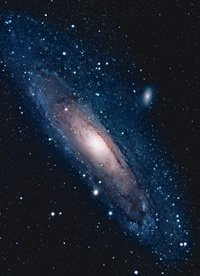
Galaxy M31 (Andromeda galaxy)
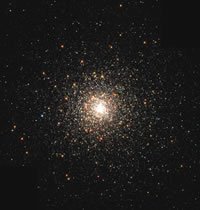
Globular Star Cluster M80
Our galaxy is shaped like a disk with a bulge in the center. Earth is located in the disk, closer to the edge than the center. The disk has spiral arms; we cannot directly see this spiral structure because we are within it. To us, the galaxy looks like a faint cloud band stretching across the sky on (northern hemisphere) summer nights (or winter nights for the southern hemisphere). This is how our galaxy gets its name—the “Milky Way.” Viewed from a distance, which of course no human being has ever done, our galaxy might look a bit like M31—the “Andromeda Galaxy” shown at right.
Our galaxy contains over 100 billion stars; the Bible says that God calls them all by their names (Psalms 147:4; Isaiah 40:26). How amazing that God has a name for each and every one of those stars! Some of these stars are far separated from their nearest neighbor, much like the sun. Some stars come in binary or multiple star systems, such as Alpha Centauri. Some stars come in large clusters. Consider the M80 star cluster. This cluster within our galaxy is estimated to contain over 100,000 stars. That means that the Milky Way has roughly a million times as many—imagine, one million stars for every single star in this cluster!
The galaxy contains more than stars. It also contains nebulae—the same stuff as stars, but whereas stars are compact spheres, a nebula is spread out over a much larger region of space. When a nebula is heated by nearby stars, it glows, often with vivid and beautiful colors. Consider the beauty of the nebulae shown, but keep in mind how enormous these objects are. The Rosette Nebula is not only beautiful, it is estimated to be more massive than 10,000 suns. The section of the Eagle Nebula shown below is several thousand times larger than our solar system. It is incredible to realize that our solar system would not even be visible on this image. God paints beautiful artwork, and He does it on a canvas of unimaginable size.
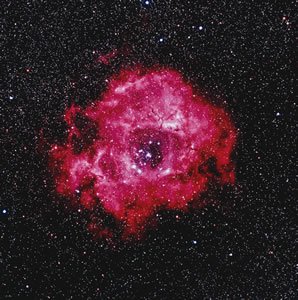
The Rosette Nebula

The Eagle Nebula
When we consider the immensity of the Milky Way, with its 100 billion stars, countless nebulae, and star clusters, the overwhelming power of the Creator becomes clear. Yet, our galaxy is not the only one. God has created innumerable galaxies with a wide range of shapes and sizes. Some galaxies are spiral, like the Milky Way and M31. Others are elliptical in shape, and some galaxies have shapes that can only be described as “irregular.” Many galaxies come in clusters. The Milky Way belongs to a cluster of a few dozen galaxies called the “Local Group.” Some clusters are much larger than this. The Virgo cluster has about 2,000 galaxies. Clusters of galaxies are organized into even larger superclusters—clusters of clusters. Superclusters show organization on the largest scales we can currently observe; they form an intricate web of strings and voids throughout the visible universe.
Just think about the quantity of energy involved when God created all this. The sun alone gives off more energy every second than one billion major cities would produce in one year. Yet, our entire galaxy is 20 billion times more luminous than the sun.3 It is estimated that there are at least as many galaxies as there are stars in the Milky Way (100 billion). Just consider such energy and mass filling a volume of space that is immense beyond our ability to fathom.
How does the Bible describe the creation of all this? Genesis 1:16 states simply that God “also made the stars.” It is astonishing that the creation of the entire universe beyond earth is described so casually by such a simple statement. The biblical description makes it sound like the creation of all the hundreds of billions of galaxies was so trivially easy for God that it barely deserves to be mentioned. How awesome is the Lord!
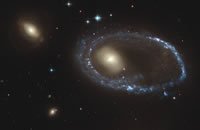
Ring galaxies are comprised of a central core surrounded by a ring of bright blue stars. Since blue stars cannot last billions of years, ring galaxies are a reminder that the universe is much younger than is generally claimed.
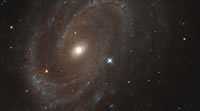
Distant Spiral Galaxy NGC 4603, Home to Variable Stars
When we contemplate all this which God created, it brings to mind Psalm 8:3–4: “When I consider your heavens, the work of your fingers, the moon and the stars, which you have set in place, what is man that you are mindful of him, the son of man that you care for him?
” It is amazing that the God who created such a universe would be concerned with something as small as human beings. Yet, Scripture makes it clear that human beings are very important to God. Our place in the universe is very significant, as we will see in later chapters.
Who would have thought from a casual glance at the night sky that the universe would be so majestic and so enormous? Certainly the night sky is stunningly beautiful, even to the unaided eye. Who could have known that it would contain hundreds of billions of galaxies, each with millions to trillions of stars, along with countless clusters and nebulae of immense size and breathtaking beauty? It seems that the more we zoom in on the universe, the more beautiful it becomes, and the more we realize how truly vast and amazing it is. The more we “magnify” the universe, the more amazed we are by its beauty and complexity. The same is true of the Creator of the universe. The more we magnify God, the more we realize just how amazing He is. It seems that God has constructed the universe to reflect this aspect of His character. Romans 1:20 indicates that many of the invisible attributes of God can be understood from the things which He made, so it shouldn’t surprise us that the universe is so incredible. Truly the heavens declare the glory of God and the skies proclaim the work of His hands!
Taking Back Astronomy
Dr. Lisle communicates the truths of creation and the fallacies of evolution with authority and enthusiasm. In this richly illustrated book, Lisle debunks the most widely accepted teachings about the idea of evolution. Readers are given solid answers to many questions, including the speed of light, the big bang, extraterrestrials, the reliability of the Bible regarding astronomy, and more.
Read Online Buy BookFootnotes
- On average; the moon’s orbit is elliptical and so its distance from earth varies. Thus its angular size varies somewhat. Sometimes the moon is slightly larger in the sky than the sun; at other times it appears a bit smaller.
- D. Faulkner, “The Angular Size of the Moon and Other Planetary Satellites: An Argument For Design,” Creation Research Society Quarterly 35(1) (June 1998): p. 23–26.
- T. Snow, The Dynamic Universe, (St. Paul, MN: West Publishing Company, 1991), 4th edition, p. 528.
Recommended Resources

Answers in Genesis is an apologetics ministry, dedicated to helping Christians defend their faith and proclaim the good news of Jesus Christ.
- Customer Service 800.778.3390
- Available Monday–Friday | 9 AM–5 PM ET
- © 2025 Answers in Genesis

